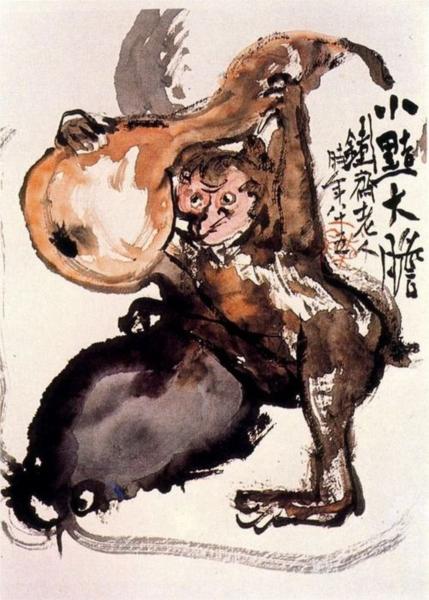Descrizione
The painting "Mono" (Mono, meaning "Monkey" in Japanese) by Tomioka Tessai is a work that reflects the artist's mastery in fusing the traditional with the innovative in 19th-century Japanese art. Considered one of the great representatives of the Nihonga style, Tessai stands out for his ability to capture the essence of Japanese nature and culture through both classical and modern techniques and themes. The work features a central image of a monkey, which becomes the vehicle through which the artist explores themes of free will, human character, and the relationship between nature and humanity.
Visually, the painting is characterized by fluid strokes and a subtle color palette that evoke a tone of exquisiteness and serenity. The monkey, the undisputed protagonist of the composition, is treated with a detailed approach that highlights the texture of its fur and the expression of its face, giving it a unique personality. This approach gives the monkey an almost anthropomorphic quality, causing the viewer to reflect on the relationship between man and ape, a common theme in Japanese art and one that finds echoes in the country's literary and folklore traditions.
The composition is cleverly balanced, with the monkey placed in a central position that draws the viewer's eye, while the background is presented in a more diffuse, almost ethereal design, evoking a sense of space and depth. The attention to detail in the depiction of the monkey is contrasted by a more softly sketched background, reinforcing the idea that the subject is not isolated, but is part of a larger, dynamic environment.
The use of color in “Monkey” is particularly notable; soft shades of grays, browns, and green hues create a tranquil atmosphere that invites contemplation. Tessai uses an almost painterly approach, similar to watercolor, where colors seem to merge into one another, creating shadows and light that bring the monkey to life. This use of color and technique emphasizes the artist’s connection to his natural surroundings.
Flourishing in a transitional period in Japan during the late Edo period and early Meiji era, Tomioka Tessai was challenged by the influence of Western art and new aesthetic and thematic currents. Through works such as "Mono," Tessai remained faithful to his training in classical Japanese art, while exploring new ways of expressing ideas through his depictions. This reflects his commitment to tradition, but also his desire to innovate and adapt to his time.
In relation to Tessai's other works, "Monkey" can be seen as part of a broader dialogue in which the artist approaches nature and living beings, allowing his works to reflect both the aesthetics he learned and his personal interpretation of reality. The use of animals, especially the monkey, is not only an artistic resource, but a powerful symbolism that runs through many dimensions of Japanese thought, encompassing spirituality, nature and cultural identity.
In short, Tomioka Tessai's "Monkey" is not just a depiction of an animal, but a profound reflection on the connection between humanity and the natural world. Its technique, subject matter and visual narrative invite the viewer to an introspective meditation on life, nature and our relationship with other forms of existence. The work stands as a testament to Tessai's talent and his place in the history of Japanese art, preserving in each stroke an echo of the wisdom that has been cultivated over generations.
KUADROS ©, a famous painting on your wall.
Hand-made oil painting reproductions, with the quality of professional artists and the distinctive seal of KUADROS ©.
Painting reproduction service with satisfaction guarantee. If you are not completely satisfied with the replica of your painting, we will refund 100% of your money.

